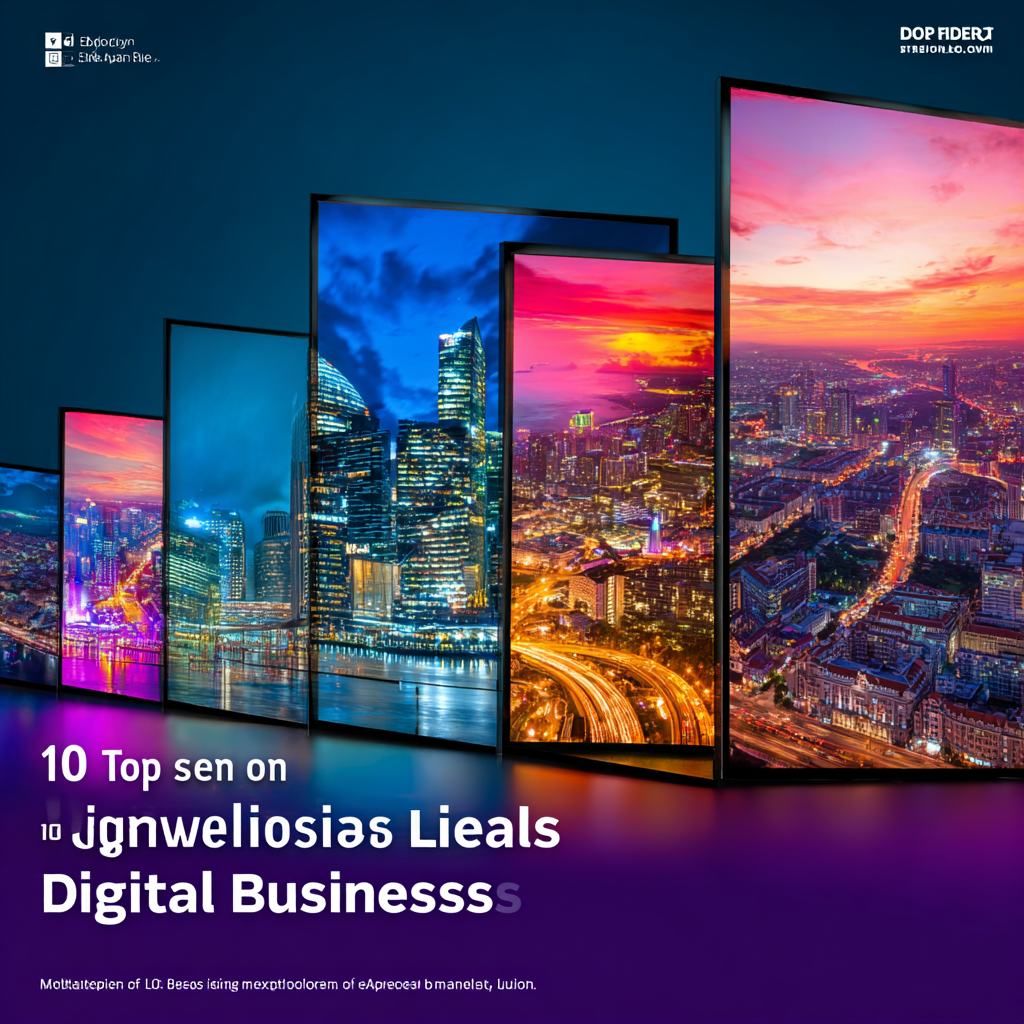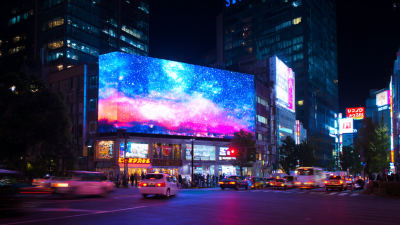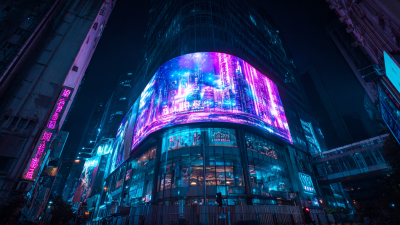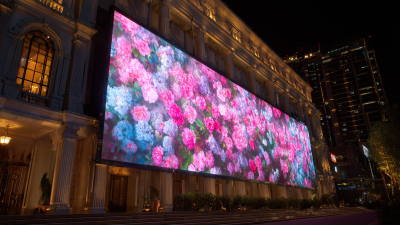
In the ever-evolving landscape of modern business, the integration of Digital LED Displays has become a pivotal strategy for organizations seeking enhanced visibility and engagement. According to a recent report by the Digital Signage Federation, the market for digital signage is projected to reach $31.71 billion by 2025, reflecting a robust growth trajectory driven by technological advancements and a rising demand for dynamic advertising solutions. Digital LED Displays offer businesses not only the ability to communicate messages effectively but also the flexibility to update content in real-time, creating a more interactive experience for consumers.

Renowned industry expert Dr. Emily Carter, a leading researcher in digital media technologies, emphasizes the significance of this shift, stating, "Incorporating Digital LED Displays into advertising strategies allows businesses to capture audience attention like never before, transforming passive viewers into active participants.” As we approach 2025, understanding the benefits of Digital LED Displays is crucial for modern businesses aiming to thrive in a competitive environment. From cost-effectiveness to enhanced brand recognition, the advantages are numerous and multifaceted, ensuring that organizations remain at the forefront of innovation and engagement.
Digital LED displays have emerged as a transformative technology for modern businesses, significantly enhancing visibility and engagement. Their vibrant colors and high-definition resolution ensure that messages are delivered effectively, capturing the attention of potential customers. With innovations such as ultra-low-power e-paper technology, companies can now benefit from displays that not only require minimal power but also boast an impressive array of colors—up to 2.5 million. This capability allows for dynamic content that can be regularly updated, making it ideal for promotions and real-time information sharing.
Moreover, advancements in LED technology, including high-visibility displays, are proving essential in public spaces such as bus stops. These displays not only improve brand engagement but also effectively communicate critical information to commuters. By utilizing these high-reliability systems, businesses can create a visually appealing environment that enhances user experience, making their offerings irresistible and engaging to passersby. In an era where visibility is paramount, investing in digital LED displays is an essential strategy for staying competitive in the fast-paced marketplace.
 The impact of digital LED displays on customer engagement cannot be overstated. As businesses increasingly adopt advanced digital signage solutions, these displays enhance the overall customer experience by offering visually stunning content that captures attention. The dynamic nature of LED displays allows for real-time updates, enabling businesses to showcase promotions, announcements, and customer testimonials effectively. This immediacy not only drives foot traffic but also fosters deeper connections with potential clients.
The impact of digital LED displays on customer engagement cannot be overstated. As businesses increasingly adopt advanced digital signage solutions, these displays enhance the overall customer experience by offering visually stunning content that captures attention. The dynamic nature of LED displays allows for real-time updates, enabling businesses to showcase promotions, announcements, and customer testimonials effectively. This immediacy not only drives foot traffic but also fosters deeper connections with potential clients.
Moreover, the integration of interactive features in digital LED displays further boosts customer participation. Interactive displays invite customers to engage with the brand directly, providing an opportunity for personalized experiences. Such technology encourages consumers to explore products, seek information, and make informed purchasing decisions, ultimately leading to increased sales. As the market for large format displays is projected to grow significantly, driven by the rising demand for digital signage, businesses investing in these technologies will likely see enhanced customer engagement and loyalty in an increasingly competitive landscape.
Digital signage is reshaping the marketing landscape for modern businesses, offering a cost-effective solution for advertising and communication. According to a report from MarketsandMarkets, the digital signage market is expected to grow from $23.1 billion in 2021 to $36.7 billion by 2026, reflecting a compound annual growth rate (CAGR) of 9.2%. This growth underscores the increasing recognition of digital displays as a viable marketing tool that not only captures attention but also enhances brand visibility at a fraction of traditional advertising costs.
One of the primary cost benefits of digital signage is its ability to streamline content updates and reduce printing expenses. Businesses can modify promotions, messages, and advertisements instantly without incurring exorbitant costs associated with static signage. A recent study from the Digital Signage Federation noted that companies using digital signage reported a 31.8% increase in sales as a direct result of engaging displays that facilitate timely and relevant messaging. This capability to quickly adapt to market trends not only boosts sales but also enables businesses to allocate their marketing budgets more efficiently, enhancing overall return on investment (ROI).
| Benefit | Description | Cost-Savings (Annual) |
|---|---|---|
| Increased Visibility | Digital displays attract more attention compared to traditional signage. | $2,000 |
| Real-Time Updates | Content can be changed on-demand to reflect promotions or news. | $1,500 |
| Improved Branding | Enhances brand image with modern technology. | $1,200 |
| Environmentally Friendly | Reduces paper waste associated with traditional advertising methods. | $800 |
| Interactive Features | Allows customer engagement through touch screens or QR codes. | $2,500 |
| Higher Sale Conversions | Proven to direct customers to make purchases. | $3,000 |
| Cost-Effective Advertising | Lower long-term costs compared to print advertising. | $2,100 |
| Dynamic Content | Ability to showcase videos and animations to capture interest. | $1,800 |
| Increased Foot Traffic | Attracts more customers to the location, boosting sales. | $2,500 |
| Remote Management | Easily control content from a remote location. | $900 |
Digital LED displays have emerged as a versatile solution across various industries, offering unparalleled flexibility in presentation styles and content delivery. In retail, for example, digital signage displays can be used to showcase promotions, engage customers with dynamic advertisements, and enhance the overall shopping experience. The interactivity of these displays further amplifies customer engagement, allowing businesses to tailor their messages according to real-time feedback and preferences.
In sectors such as hospitality and transportation, outdoor displays provide vital information with high visibility and clarity. These screens can broadcast schedules, updates, and safety information effectively to large audiences in busy environments. Meanwhile, interactive displays have transformed conference rooms and education sectors by facilitating collaborative learning and seamless communication. The adaptability of LED video walls allows for imaginative presentations in corporate settings, event management, and entertainment, proving that the application of digital LED displays is both diverse and impactful across modern business landscapes.

Digital LED displays have revolutionized the way modern businesses communicate with their audiences, primarily due to their ability to provide real-time content updates. According to a report from the Digital Signage Federation, businesses that utilize digital signage see a 30% increase in audience engagement compared to static displays. This real-time capability allows companies to quickly adapt their messaging according to changing customer needs, promotional events, or breaking news, making their communications more relevant and timely.
Moreover, research from Nielsen shows that consumers engage better with dynamically updated content. In fact, messages updated in real-time can increase viewer retention by 47%, an essential factor in maximizing advertising effectiveness. Businesses can leverage this advantage to showcase time-sensitive promotions, seasonal offers, or important announcements, significantly enhancing customer interaction and driving sales. With the fast-paced environment of today's marketplace, the ability to update content instantly not only keeps a brand agile but also offers a significant competitive edge.











